Philosophy
易經
I Ching
Using the I Ching
General Overview
If you are not familiar with using the I Ching, the learning curve can be be a bit steep, but I will layout some basics that should make it easier, plus there is a tool included here to calculate your hexagram, changing lines, if any, and resulting hexagram from the numbers you generate using your sticks.
This page should help you get started on your I Ching journey, or continue it.
If you see square boxes or ? type characters instead of Chinese characters, you may need to install hanazono fonts. You can visit the China Text Project font test page to see. That page has instructionis for Windows and OSX users. Linux users can simply install the package fonts-hanazono (apt, rpm), ttf-hanazono (pacman, slackbuilds).
Result Calculator
To generate your hexagrams, complete the form, and click Generate.
How to Get a Reading
IMPORTANT: If you are actually trying to learn something in your queries, don't use the coin method, that's lazy, and inaccurate. The math is significantly different re probabilities than using the 50 sticks in repeated operations, plus you are just being lazy, and you won't get reliable or good results if that's how you want to approach this. So I'm not going to even talk about the coin method here at all.
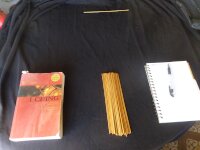
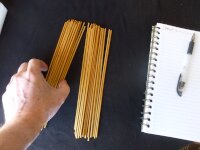

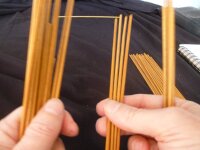
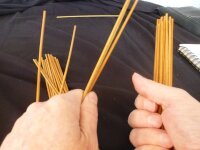
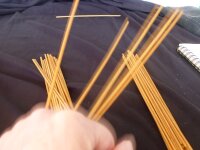
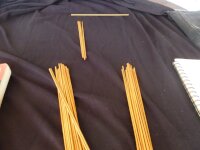
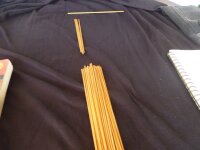
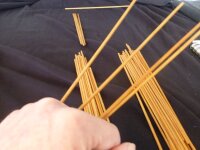
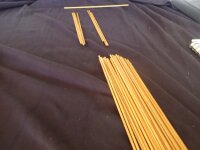
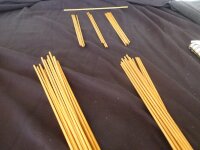
It's also very important to try to clear your mind, and ask the real question you have, not the one you might wish or think you have. My experience has shown me that the I Ching will generally answer your real question. I find it helps to write down your question, above the numbers you write down, and the date you asked it, so you can refer back to it in the future. The I Ching does not like being treated lightly, or being abused, and will generally let you know if that is what you are doing.
Follow these steps to prepare yourself:
- Get your sticks. You need 50, though getting a spare or two isn't the worst idea, just make sure to not mix the spares with your working set. I like the bamboo skewers you can get in markets. Trim off the sharp end, sand them down to make smooth, and maybe apply a light oil to them so they will last a long time. If you oil them, let them dry a long time! Take care of your sticks, put them in a nice pouch or something, treat them with respect.
- Place the 50 sticks on your working surface. Take 1 stick and place it over, and perpendicular to, the pile, leaving enough room between the pile and that one to place your sticks as you generate the 3 piles that make up each line. This is the covering stick, and will not be touched again. It is like the roof, or cover, of the actions to follow. Make sure to not touch it, don't hit it with your sticks, make sure it's far enough above your working area to be clear of the main pile, and the working 3 piles as you generate them. It can also be thought of as the One, or the Tao, which covers and supports everything, but which you do not directly interact with.
- Without thinking, divide the pile (which is perpendicular to you) into two parts. Take one stick from the right half's pile, and stick in between your little and ring finger of your left hand. It will stay there for the next set of operations.
- During all manipulations, except for picking up sticks, or putting down a completed set of 3 manipulations to form a pile, you keep the sticks in your hands. This is part of the focus element of the manipulation. Once you get used to holding the sets in between your left fingers, the working pile in your left palm, and pulling out the sets of 4 with your right hand, you'll be surprised how easy this is to do.
- Take the left pile in your left hand, the one where you stuck the single stick, and start pulling out sticks in groups of 4, store those in your right hand. Keep going until you are left with 4 or fewer sticks in your left hand.
- Take those remainders in your left hand and stick them between your ring and middle finger of your left hand.
- Repeat the steps in 3-4, you will be left with between 1 and 4 sticks each time. Stick the second remainder between your middle and index finger.
- Take the 3 groups of sticks you have stuck between the fingers of your left hand, and put those down as one small pile, between the main pile, and the single stick you put above everything when you started. Now you have the top, covering single stick, and a pile of 5 or 9 sticks (for first pile), or 4 or 8 (for the 2nd and 3rd piles).
- Now combine the remaining sticks of the 2 piles back into one bigger pile, and split those again (minus the first pile you have created). Split without intention or thinking, try to empty your mind. This gives generally the best results.
- The 1st set of 3 manipulations will leave you with 5 or 9 sticks total, including the one you stuck in between your little finger and ring finger. The 2nd and 3rd sets of 3 will end up with 4 or 8 sticks total. If you ended up with any other number, you made a mistake, or you started out with the wrong number of sticks. Focus, you have to pay attention to get real results.
- Once you are done, you have 3 little piles, the 5 or 9 one on the left, then a 4 or 8, then another 4 or 8 to the right of that, perpendicular to the top covering stick. Count up these totals. Take these numbers and write them down. I suggest getting a small notebook you can keep with your sticks, and writing them down in there. When you write them down, write the first line you made first, then go down to the 6th line.
- Congratulations! You have now generated the numbers to get your first, or bottom, line, of the hexagram you will end up with. Repeat steps 3-8 5 more times, until you end up with 6 sets of numbers.
- The final results will look something like this (remember, the first line is
going to be the bottom line of your hexagram, the 6th line, the top):
5 8 8 (1)
9 4 4 (2)
5 8 8 (3)
5 4 4 (4)
9 8 8 (5)
5 4 8 (6)
You can also make two stacks of 3 if you like, I find that convenient, like so:
5 8 8 (1) | 5 4 4 (4)
9 4 4 (2) | 9 8 8 (5)
5 8 8 (3) | 5 4 8 (6)
Those 2 stacks of 3 also form the trigrams your hexagram will be made out of. - If you have not memorized the hexagrams yet, you can just pop those numbers into the 1-6 calculator fields above, and it will tell you the first starting hexagram, with changing lines if they happen, and the resulting hexagram, that is, what the changes change into.
Understanding the Lines, Trigrams, and Hexagrams
Yin () is the feminine, or receptive/generative principle. Yang () is the masculine, creative principle. The numbers map to the lines as follows:
- 5 4 4: Changing yang to yin:
⇾ - 5 4 8 / 5 8 4: Yin:
- 5 8 8: Yang:
- 9 4 4: Yin:
- 9 4 8 / 9 8 4: Yang:
- 9 8 8: Changing yin to yang:
⇾
These are the only possible combinations you can get. If you get anything else, you made a mistake, and are not focused, or didn't start with the right count of 50 sticks, which again means, you weren't focused. The I Ching is a very well designed tool, because it carries inside its operation its own error / focus failure detectors,
Applying these tranformations to the 6 lines we are using from above, we get:
Which is hexagram 55 (progress) changing to 63 (completion), with 4th and 5th lines changing. 55 is made out of the trigrams Fire ( ) under Thunder ( ), and 63 is made out of the trigrams Fire ( ) under water ( ). You'll notice that the bottom trigram Fire does not change in this reading. Thunder changes into Water, however.
Chinese tends to be very visual, so here you have an image of thunder over fire changing to water over fire.
The bottom 3 lines (1-3) are known as the inner trigrams, and the outer 3 (4-6) as the outer.
There are 8 trigrams out of which a hexagram can be made:
- 乾 Heaven, force, the sky (qián, qian)
- 兌 Water, collected as in a marsh or lake; open (du, dui)
- 離 Fire, as in lightning; the sun (lí)
- 震 Thunder, shake (zhèn, zhen)
- 巽 Wind; wood (xùn, xun)
- 坎 Water, as in rain, clouds, springs, streams, gorge; the moon (kǎn, kan)
- 艮 Hills, mountains, bound (gèn)
- 坤 The earth, field (kūn, kun)
There are also what are known as the nuclear trigrams, which refer to the trigrams the 2nd, 3rd, 4th lines, and the 3rd, 4th, 5th lines create. Those are harder to get a sense of, so don't worry about those for now.
Wikipedia has an unusually good set of articles on the I Ching (includes historical overview, and general principles), trigrams, and an in-depth list of hexagrams. If you want to expand your understanding of this tool, I recommend all 3 of the articles.
Interpreting the Hexagrams and Changes
You can get from 0 to 6 changing lines. As a general rule, the more changing lines you get, the more dynamic the situation is. If you get none, then it's a pretty stable declaration of where things are at now. Changing lines 3 and 6 are often complicated or difficult, and need to be paid special attention to, with a few exceptions.
I find that the lines starting with 9 tend to be more powerful, and likewise, tends to be difficult, and if in certain positions, can be quite challenging. This is the nature of power, of course. If you get several lines starting with 9 in a reading, that indicates something powerful is at work, like the full moon for example. This is worth noting, which is why you want to write down your 6 sets of 3 numbers, along with the question, and the date, so you can refer back to it later.
Some changing lines and hexagrams are incredibly good, and some very bad, but most are between those poles. If you get serious warnings, pay attention! Make sure you understand what the probable reference is.
Sometimes understanding the hexagrams and changing lines is difficult, but gets more obvious over time as the changes unfold.
Math and Probabities
If you are observant, you may nave noticed that when you add the 3 numbers up for the lines, 17 gives a yin line () with 7 in 16 odds, 21 gives a yang line () with 5 in 16 odds, 13 the yang to yin changing line () with 3 in 16 odds, and 25 the yin to yang changine line () with 1 in 16 odds. The latter is the least likely line (you have to end up with 9s/8s each time you do the split). There are 3 direct ways to get a yin (9+4+4, 5+8+4, 5+4+8), and 3 direct ways to get a yang line (9+4+8, 9+8+4, 5+8+8).
There is only 1 way to get a 9: 1+4+4. There are three ways to get a 5: 1+1+3, 1+3+1, 1+2+2. There are 2 ways to get 8s: 1+3+4, 1+4+3, and 2 ways to get a 4: 1+1+2, 1+2+1. For the second and third lines, 8 8 and 4 4 are the least common combinations, and 4 8 / 8 4 the most common.
This shows up in practice with the basic tendencies: a 9 is likely to turn into a yang line, and a 5 is likely to turn into a yin line. The probabilities reflect this. A 9 is less likely to turn into a yin line, and least likely to become a changing yin to yang line. A 5 is less likely to turn into a yang line, and least likely to become a changing yang to yin line. This is another reason the coin method is simply not the same. Suffice it to say, if you get a bunch of changing lines, pay attention, because the odds are massively against getting more than 1.
However, in my view, the real difference is because you are taking a lot longer, and having to focus much more, when you use the sticks. And it requires more distinct actions by you, and thus, more focus.